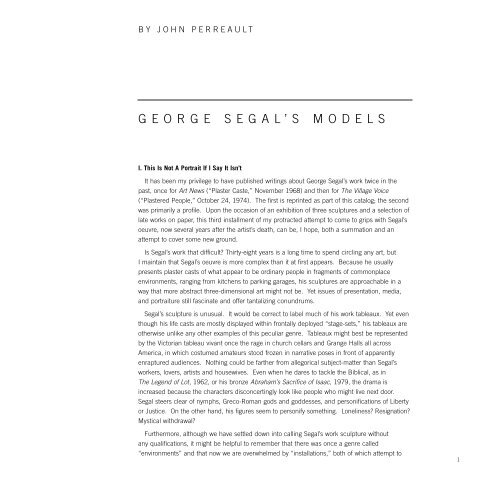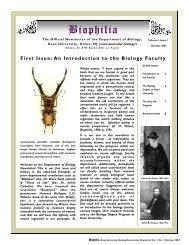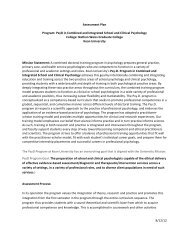GeorGe SeGal - Kean University
GeorGe SeGal - Kean University
GeorGe SeGal - Kean University
You also want an ePaper? Increase the reach of your titles
YUMPU automatically turns print PDFs into web optimized ePapers that Google loves.
BY JoHn PErrEAuLt<br />
GEorGE SEGAL’S MoDELS<br />
I. This Is Not a Portrait If I Say It Isn’t<br />
It has been my privilege to have published writings about George Segal’s work twice in the<br />
past, once for Art News (“Plaster caste,” november 1968) and then for The Village Voice<br />
(“Plastered People,” october 24, 1974). the first is reprinted as part of this catalog; the second<br />
was primarily a profile. upon the occasion of an exhibition of three sculptures and a selection of<br />
late works on paper, this third installment of my protracted attempt to come to grips with Segal’s<br />
oeuvre, now several years after the artist’s death, can be, I hope, both a summation and an<br />
attempt to cover some new ground.<br />
Is Segal’s work that difficult? thirty-eight years is a long time to spend circling any art, but<br />
I maintain that Segal’s oeuvre is more complex than it at first appears. Because he usually<br />
presents plaster casts of what appear to be ordinary people in fragments of commonplace<br />
environments, ranging from kitchens to parking garages, his sculptures are approachable in a<br />
way that more abstract three-dimensional art might not be. Yet issues of presentation, media,<br />
and portraiture still fascinate and offer tantalizing conundrums.<br />
Segal’s sculpture is unusual. It would be correct to label much of his work tableaux. Yet even<br />
though his life casts are mostly displayed within frontally deployed “stage-sets,” his tableaux are<br />
otherwise unlike any other examples of this peculiar genre. tableaux might best be represented<br />
by the Victorian tableau vivant once the rage in church cellars and Grange Halls all across<br />
America, in which costumed amateurs stood frozen in narrative poses in front of apparently<br />
enraptured audiences. nothing could be farther from allegorical subject-matter than Segal’s<br />
workers, lovers, artists and housewives. Even when he dares to tackle the Biblical, as in<br />
The Legend of Lot, 1962, or his bronze Abraham’s Sacrifice of Isaac, 1979, the drama is<br />
increased because the characters disconcertingly look like people who might live next door.<br />
Segal steers clear of nymphs, Greco-roman gods and goddesses, and personifications of Liberty<br />
or Justice. on the other hand, his figures seem to personify something. Loneliness? resignation?<br />
Mystical withdrawal?<br />
Furthermore, although we have settled down into calling Segal’s work sculpture without<br />
any qualifications, it might be helpful to remember that there was once a genre called<br />
“environments” and that now we are overwhelmed by “installations,” both of which attempt to<br />
1

















